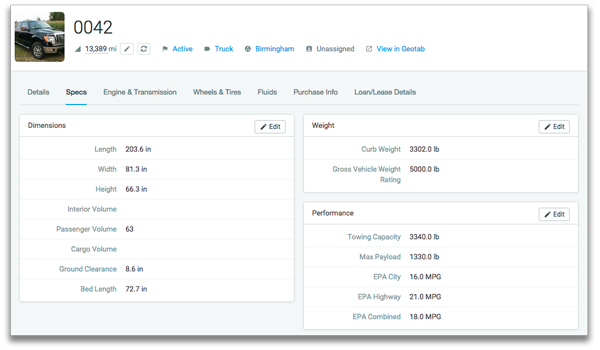

Mar 18 2016
By Fleetio
In a previous blog article, we highlighted a few ways in which a VIN decoder can add value to fleet management software. So, we thought it'd be helpful to have a fleet management software provider offer further insight on the subject.
In this guest post, Lori Higdon from Fleetio has taken a deeper dive into how VIN decoding can increase the efficiency of fleet management. Without further ado:
By: Lori Higdon, Marketing Director at Fleetio
Knowing everything about your fleet is key to being a great fleet manager. But whether you are managing a fleet of 5 or 5,000 assets, keeping track of every vehicle’s specs and details can prove to be difficult and time-consuming.
Since a vehicle identification number (VIN) is like a vehicle’s DNA, it is a key piece of fleet management. All of the information provided by a VIN is crucial to the usage and maintenance of a vehicle throughout its entire lifecycle. To use VIN information to a fleet’s advantage, though, data must be kept readily accessible to anyone touching the fleet. Fleet management software with VIN decoding functionality makes it easy.
When using fleet management software to decode a vehicle’s VIN, you can instantly populate a vehicle record with all data associated with that vehicle. This allows you to increase fleet operations efficiencies by eliminating manual data entry, ensuring data accessibility from anywhere and using data to make more informed decisions.
When decoding a VIN with a fleet management software like Fleetio, the process is instant. Users can simply add a 17-digit VIN and hit decode. The system then automatically populates all information related to that vehicle. Within the vehicle record, data is safely stored and organized.
Tons of actionable data points are collected from a VIN:
Automatically looking up vehicle information saves time and frustration by completely eliminating manual data entry. When recording vehicle specs and details by hand, you first have to dig up the information. This means researching the vehicle via the OEM, various manuals or otherwise.
Manual entry can not only be time-consuming, but it also creates a large risk of error. Decoding VINs automatically ensures you have the most complete, accurate data on each fleet vehicle.

Fleet management software users can save even more time by decoding VINs in bulk and clean up data by decoding vehicles already existing in the system. When a vehicle has a few specs on file, it’s simple to fill in the remaining information to ensure you always have the data you need on hand.
Fleets are mobile by nature, so vehicle data provided by a VIN needs to be accessible anytime, anywhere. Most decisions regarding fleet vehicles aren’t made at a desk, so secure access is crucial to productivity.
In addition, it’s important for anyone touching the fleet to have controlled access to VIN data. When team members are waiting to access vehicle data after returning to the office, efficiency is challenged. Even worse, employees may take a guess about vehicle specs if information isn’t readily available.
In the shop: Fleet managers can use VIN data to make quick decisions regarding vehicle maintenance. In-house mechanics or external vendors can even be given access to relevant data so they don’t have to involve the fleet manager.
At the construction site: Fleet managers can make decisions on which vehicles it will take to get the job done based on VIN data like towing capacity, ground clearance, weight and more.
When detailed vehicle data is accurate and accessible, it can be used to make smarter decisions regarding the fleet. VIN data can inform maintenance and usage decisions, vehicle comparisons, vehicle replacement and much more.
Select the right vehicle for the job. Specs like towing capacity, clearance and weight would be key for heavy-duty jobs while vehicles with the best fuel economy and safety ratings would be ideal for long distance trips. Storing VIN data in a fleet management software allows users to compare specs and performance of fleet vehicles at any time.
Inform maintenance tasks. Specs can help pinpoint the ideal service schedule, ensuring vehicles aren’t over- or under-maintained. This lengthens the vehicle’s lifecycle, ensures uptime and reduces costs. When VIN information is coupled with usage data in a fleet management system like Fleetio, users can even predict future maintenance tasks based on actual utilization.
Spec and replace assets. Over time, the fleet will change based on the needs of your business. Fully understanding your fleet helps you spec the right vehicles as your fleet grows and replace the appropriate assets when needed.
By using fleet management software that offers a VIN decoding feature, you can eliminate time-consuming data entry by instantly populating actionable vehicle data and offering access to the appropriate people. Using VIN data becomes a huge win when you can increase efficiency and make smarter decisions.
Lori Higdon is Marketing Director at Fleetio, a web-based fleet management software that allows users to cut through the chaos of fleet management and gain visibility into fleet operations. Learn about Fleetio features like VIN decoding, GPS integration, fuel card integration and more at fleetio.com.